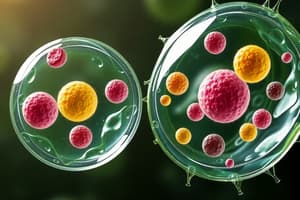Podcast
Questions and Answers
What does the cell theory state?
What does the cell theory state?
- All organisms are made of cells.
- All cells are produced by other living cells.
- The cell is the most basic unit of life.
- All of the above. (correct)
What is cytoplasm?
What is cytoplasm?
Jellylike substance inside cells that contains molecules and, in some cells, organelles.
What is an organelle?
What is an organelle?
Membrane-bound structure that is specialized to perform a distinct process within a cell.
A prokaryotic cell has a nucleus.
A prokaryotic cell has a nucleus.
A eukaryotic cell contains a nucleus.
A eukaryotic cell contains a nucleus.
What is the function of the cytoskeleton?
What is the function of the cytoskeleton?
What does the nucleus store?
What does the nucleus store?
What is the role of the endoplasmic reticulum?
What is the role of the endoplasmic reticulum?
What links amino acids together?
What links amino acids together?
What is the function of the Golgi apparatus?
What is the function of the Golgi apparatus?
What are vesicles used for?
What are vesicles used for?
What is the function of mitochondria?
What is the function of mitochondria?
What does a vacuole store?
What does a vacuole store?
What does a lysosome contain?
What does a lysosome contain?
What is the role of a centriole?
What is the role of a centriole?
What is a cell wall?
What is a cell wall?
What do chloroplasts convert?
What do chloroplasts convert?
What is the function of the cell membrane?
What is the function of the cell membrane?
What is a phospholipid?
What is a phospholipid?
What is the fluid mosaic model?
What is the fluid mosaic model?
What does selective permeability refer to?
What does selective permeability refer to?
What is the role of receptors in cells?
What is the role of receptors in cells?
What is passive transport?
What is passive transport?
What is diffusion?
What is diffusion?
What is a concentration gradient?
What is a concentration gradient?
What is osmosis?
What is osmosis?
What describes an isotonic solution?
What describes an isotonic solution?
What describes a hypertonic solution?
What describes a hypertonic solution?
What describes a hypotonic solution?
What describes a hypotonic solution?
What is facilitated diffusion?
What is facilitated diffusion?
What is active transport?
What is active transport?
What is endocytosis?
What is endocytosis?
What is phagocytosis?
What is phagocytosis?
What is exocytosis?
What is exocytosis?
Flashcards are hidden until you start studying
Study Notes
Cell Theory
- All organisms consist of cells; cells are the fundamental units of life.
- Cells arise from pre-existing living cells.
Cytoplasm
- Jellylike substance found within cells, containing molecules and organelles.
Organelles
- Specialized, membrane-bound structures within cells that perform distinct functions.
Prokaryotic and Eukaryotic Cells
- Prokaryotic cells lack a nucleus and membrane-bound organelles.
- Eukaryotic cells possess a nucleus and other specialized membrane-bound organelles.
Cytoskeleton
- A network of proteins, including microtubules and microfilaments, that provides support and shape to eukaryotic cells.
Nucleus
- Double-membrane organelle that stores most of a cell’s DNA.
Endoplasmic Reticulum (ER)
- Network of folded membranes involved in protein production, processing, and distribution.
Ribosomes
- Organelles responsible for linking amino acids to form proteins, can be free-floating or attached to the ER.
Golgi Apparatus
- Stack of membrane-enclosed spaces that processes, sorts, and delivers proteins.
Vesicles
- Small organelles that transport materials within the cytoplasm.
Mitochondrion
- Energy-producing organelle with its own ribosomes and DNA, often referred to as the cell's power plant.
Vacuoles
- Organelles used for storing materials such as water, food, or enzymes.
Lysosomes
- Organelles containing enzymes that function in digestion and waste processing.
Centrioles
- Cylinder-shaped organelles composed of protein tubes, aiding in cell division (mitosis).
Cell Wall
- Rigid structure providing protection, support, and shape to plant, algae, fungal, and bacterial cells.
Chloroplast
- Organelles that convert solar energy into chemical energy through photosynthesis, contain chlorophyll.
Cell Membrane
- Double-layer of phospholipids that serves as a barrier between the cell and its environment, regulating material passage.
Phospholipid
- Glycerol molecule with a phosphate group and two fatty acids, crucial in forming cell membranes.
Fluid Mosaic Model
- Describes the arrangement and movement of molecules within a cell membrane.
Selective Permeability
- Quality of a membrane that allows certain substances to cross while blocking others.
Transport Processes
- Passive transport requires no energy for molecules to move across membranes.
- Diffusion is the movement from regions of higher to lower concentration.
- Osmosis is the specific diffusion of water across a semipermeable membrane.
- Isotonic solutions have equal concentrations; hypertonic has higher; hypotonic has lower compared to another solution.
- Facilitated diffusion involves protein channels assisting molecule movement.
- Active transport is energy-dependent movement from lower to higher concentration.
Endocytosis and Exocytosis
- Endocytosis is the process of taking in liquids or large molecules through membrane folding.
- Phagocytosis is a type of endocytosis that involves engulfing solid particles.
- Exocytosis is the release of substances from a cell via vesicle fusion with the membrane.
Studying That Suits You
Use AI to generate personalized quizzes and flashcards to suit your learning preferences.




